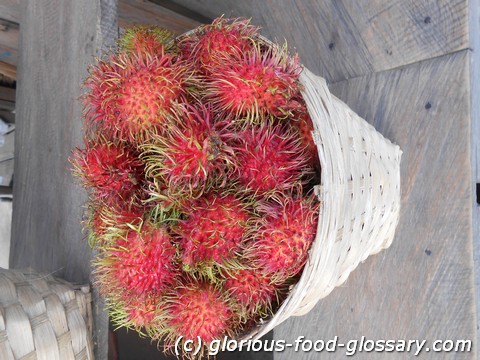Rambutan in the food context refers to a tropical fruit native to Southeast Asia, often recognized by its hairy or spiky outer skin. The scientific name of this fruit is Nephelium lappaceum. Rambutan is renowned for its sweet and juicy flesh, making it a popular fruit in many countries with tropical climates. It is enjoyed fresh as a snack, used in desserts, and sometimes even processed into jams or canned fruit.
Application Areas: Rambutan is a versatile fruit used in various culinary applications, including:
- Fresh Consumption: Rambutan is typically eaten fresh, with the outer skin removed to reveal the juicy, translucent flesh.
- Desserts: It is a common ingredient in fruit salads, ice creams, and tropical fruit desserts.
- Preserves: Rambutan can be used to make jams, jellies, and fruit preserves.
- Beverages: Its sweet flavor is utilized in beverages like Rambutan smoothies and cocktails.
Examples of National and International Dishes:
- Indonesia: Rambutan is often added to a traditional Indonesian fruit salad known as "rujak."
- Malaysia: In Malaysia, Rambutan is used in a popular dessert called "Rojak Buah," which includes a mix of fruits and a sweet, spicy sauce.
- Thailand: Thai cuisine incorporates Rambutan in both savory and sweet dishes, including salads and fruit-based sauces.
Risks:
- Allergies: While Rambutan is generally safe to consume, some individuals may have allergies to certain fruits. Allergic reactions can range from mild itching to severe anaphylaxis. It is essential to exercise caution if you have known fruit allergies.

Recipe - Rambutan Salad: Ingredients:
- 2 cups peeled and deseeded Rambutan
- 1 cup pineapple chunks
- 1 cup papaya chunks
- 1/4 cup fresh lime juice
- 2 tablespoons honey
- Fresh mint leaves for garnish
- In a large bowl, combine the Rambutan, pineapple, and papaya.
- In a separate small bowl, whisk together the lime juice and honey to create the dressing.
- Pour the dressing over the fruit and gently toss to combine.
- Chill the salad in the refrigerator for about 30 minutes before serving.
- Garnish with fresh mint leaves.
Examples of Sentences:
- I enjoyed a ripe Rambutan for breakfast.
- The sweetness of Rambutan's flesh is delightful.
- We bought a bag of fresh Rambutans from the market.
- She was savoring the Rambutan's juicy goodness.
Similar Foods and Synonyms:
- Lychee: Lychee is a fruit with a similar sweet taste and texture to Rambutan.
- Longan: Longan is another tropical fruit related to Rambutan and Lychee.
- Mamoncillo: Also known as "Spanish lime," it shares some similarities in appearance with Rambutan.
Articles with 'Rambutan' in the title
- Puno ng Rambutan: Puno ng Rambutan refers to the tree that bears the rambutan fruit, a popular tropical fruit native to Southeast Asia. The rambutan tree is part of the Sapindaceae family, which also includes other well-known fruits like lychee and longan
Summary
Rambutan is a tropical fruit known for its sweet and juicy flesh, encased in a hairy or spiky outer skin. It is widely enjoyed fresh, added to various desserts, and used in beverages. While generally safe to eat, individuals with fruit allergies should be cautious. Rambutan is a versatile ingredient in Southeast Asian cuisine, contributing to the rich and diverse flavors of the region.--
Related Articles to the term 'Rambutan' | |
| 'Puno ng Rambutan' | ■■■■■■■■■■ |
| Puno ng Rambutan refers to the tree that bears the rambutan fruit, a popular tropical fruit native to . . . Read More | |
| 'Calamansi' | ■■■■■■■■ |
| Calamansi in the food context refers to a small, citrus fruit native to the Philippines and other Southeast . . . Read More | |
| 'Achar' | ■■■■■■■■ |
| Achar is a term used to describe a variety of pickled foods, prevalent in the cuisines of the Indian . . . Read More | |
| 'Dalanghita' | ■■■■■■■■ |
| Dalanghita in the food context refers to a type of citrus fruit that is widely cultivated and consumed . . . Read More | |
| 'Dragon Fruit' | ■■■■■■■■ |
| Dragon Fruit, in the food context, refers to the fruit of several different cactus species indigenous . . . Read More | |
| 'Chom chom' | ■■■■■■■ |
| Chom chom is a Vietnamese term for rambutan. A rambutan tree has broad foliage and many branches. In . . . Read More | |
| 'Fruit' | ■■■■■■■ |
| Fruit refers to any product of plant growth useful to humans or animals, such as apples, pears, plums, . . . Read More | |
| 'Cherry' | ■■■■■■■ |
| Indian: Cherry, Cherrypazham The cherry is the fruit of many plants of the genus Prunus, and is a fleshy . . . Read More | |
| 'Brombeer' | ■■■■■■■ |
| In the food context, \'Brombeer\' refers to the blackberry, a fruit produced by many species in the Rubus . . . Read More | |
| 'Tamarindo' | ■■■■■■■ |
| Tamarindo refers to the fruit of the Tamarindus indica tree, native to Africa but widely cultivated in . . . Read More | |
